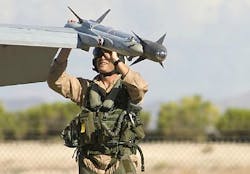Raytheon to upgrade AIM-9X air-to-air missile to extend its range and replace obsolescent parts
PATUXENT RIVER NAS, Md., 24 Aug. 2012. Engineers at the Raytheon Co. Missile Systems segment in Tucson, Ariz., are making plans to upgrade the U.S. military's AIM-9X Sidewinder air-to-air missile to extend the weapon's range and address existing obsolescence issues.
The AIM-9X is a relatively short-range infrared heat-seeking missile that equips most jet fighters, fighter-bombers, and other offensive combat aircraft in the U.S. arsenal, and is used to shoot down enemy aircraft close by. The AIM-9X works by homing in on an enemy aircraft's hot engine exhaust. Variants of the AIM-9 Sidewinder have been deployed since the 1950s.
Officials of the U.S. Naval Air Systems Command at Patuxent River Naval Air Station, Md., announced plans this month to award a sole-source contract to Raytheon to perform missile upgrades on the AIM-9X not only to extend the missile's range and deal with obsolescent components, but also to address insensitive munitions requirements.
Insensitive munitions, mandated by U.S. law, refer to weapons that only burn, rather than explode, when subjected to unintentional slow or fast heating, bullets, shrapnel, shaped charges, or the detonation of another nearby munition.
Military officials want to ensure the AIM-9X does not explode unintentionally due to accidents or combat damage to safeguard military personnel and equipment from weapons-related accidents.
The Navy is awarding a sole-source to Raytheon for the AIM-9X upgrades because the company is the original manufacturer of the missile, and military officials have determined that only one responsible source and no other supplies or services will satisfy military requirements. The amount of the contract has yet to be negotiated.
| Related stories -- Raytheon to provide AIM-9X missiles for US Navy -- Raytheon AIM-9X Sidewinder demonstrates air-to-surface capability -- Raytheon moves to full production of AIM-9X missile. |
Hughes Missile Systems won a competition to design and build the AIM-9X -- short for air intercept missile -- in 1996. Raytheon subsequently acquired Hughes Missile Systems in 1997. In the AIM-9X contract, the military did not buy a technical data package for re-procurement purposes, and required Raytheon to retain configuration control of all items not affecting the system specification.
Access to the technical data package is necessary for the AIM-9X missile upgrades, and awarding a contract to any other company than Raytheon would cause substantial duplication of costs and design delays, Navy officials say.
The AIM-9X is among the latest versions of the AIM-9 missile family. It entered service in 2003 on the Navy F/A-18C Hornet fighter-bomber and on the U.S. Air Force F-15C jet fighter. It has an imaging infrared focal plane array seeker with 90-degree off-boresight capability for accuracy.
The missile is compatible helmet-mounted displays such as the U.S. Joint Helmet Mounted Cueing System, and features 3-D thrust-vectoring control for increased turn capability. The AIM-9X also includes an internal cooling system.
The latest version of the AIM-9X is called the AIM-9X Block II, which is undergoing testing this year. This newest version has lock-on after launch capability for use with the F-35 Lightning II joint strike fighter and the F-22 Raptor advanced tactical fighter.
For questions or concerns about the pending sole-source contract to Raytheon to upgrade the AIM-9X, contact Raytheon's Mark Gottshall by phone at 520-794-0557, or by e-mail at [email protected].
For more information contact Raytheon Missile Systems online at www.raytheon.com/businesses/rms, or Naval Air Systems Command at www.navair.navy.mil.
Follow Military & Aerospace Electronics and Avionics Intelligence news updates on Twitter

